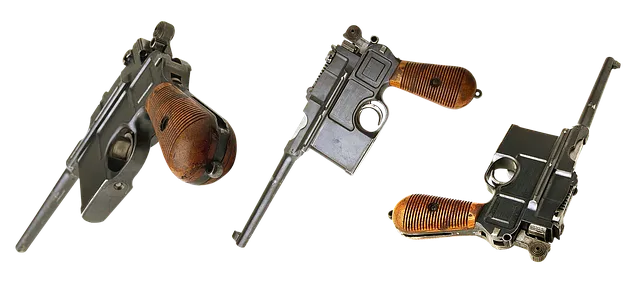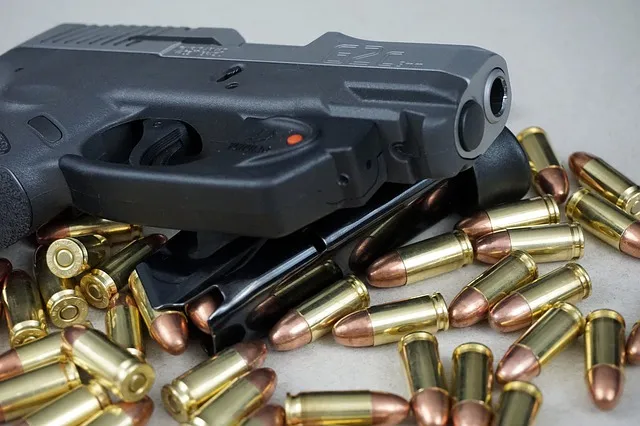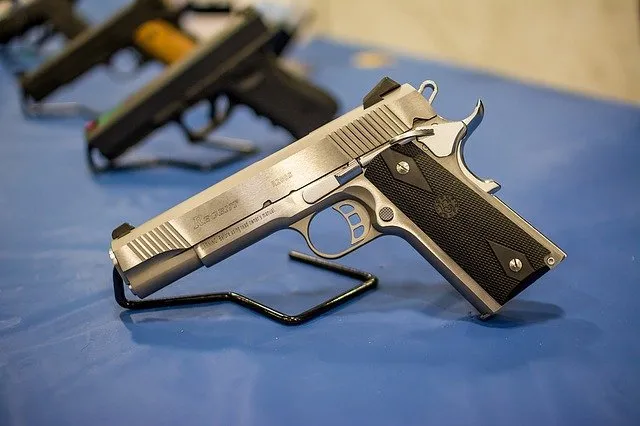In Part 1, I offered a cursory overview of single-action and double-action revolvers along with common calibers used in the US. Now it's time to take a look at semi-automatic handguns compared with one another and weighed against wheelguns.
A Cursory History
Once smokeless powder was invented, the possibilities for firearm design were no longer constrained by black powder fouling. In addition, the greater pressures achieved by smaller volumes of powder resulted in smaller cartridges with more performance potential. However, experiments by gunsmiths around the world had mixed results. At the risk of oversimplification, there are essentially two eras of magazine-fed semi-automatic handguns: Before John Moses Browning, and after.

Mauser C96. Image credit
Many early designs used clips similar to those employed in bold-action military rifles. The Mauser C96 was a successful example of this pattern, although it is better known through popular culture as the foundation for Han Solo's blaster pistol in Star Wars nowadays. Slightly earlier, the Borchardt C93 exhibited the more modern-looking box magazine inside the pistol grip, but suffered from bad ergonomics and a bulky mechanism that never met with great success. However, it did inspire the much more successful Luger.
By World War I, the standard form factor we expect to see today had largely been established: A magazine in the grip frame, and a slide on top to pull rounds from the mag and into the chamber as the action cycles under recoil.
All three of the models I mentioned above are designed to use some kind of mechanical locking system to manage the pressure from the cartridge and delay opening the breech until that pressure has a chance to drop after the bullet leaves the barrel. However, many rounds use a simple blowback mechanism instead. The mass of the slide combined with spring pressure can be sufficient to control the cycling operation, particularly with lower-pressure rounds.
Blowback Cartridges
The oldest cartridge still commonly used in semi-automatic pistols is the venerable .22 Long Rifle rimfire cartridge mentioned in the last installment as a common revolver cartridge. While usually deemed wholly inadequate as a self-defense round, it is popular in target pistols and quite capable of taking small game. It is hypothesized to be the most popular poaching caliber for deer, too. Its low recoil is ideal for simple blowback designs. However, it is not common in defensive handguns.
For purpose-built defensive arms, we look again to Browning and his series of centerfire rounds.
Browning partnered with FN Herstal of Belgium to produce the .32 ACP cartridge and an extremely successful blowback-operated pocket pistol. A few years later, a smaller .25 ACP cartridge was released alongside the Model 1905. Both of these rounds are still widely available, and firearms are still produced for them, although these tend to be considered cheaper guns with lower quality, and the rounds are not usually considered adequate for reliable self-defense. However, the .32 ACP was widely used in military sidearms by officers in almost all World War I military forces.
1908 saw the release of another Browning-designed cartridge still considered acceptable for self-defense: the .380 ACP/9x17mm/9mm short. Many simple blowback and locked breech designs use this round even today, and many are considered quite good guns. Modern bullet design and powder formulations have also improved its performance. Prior to World War II, several nations even adopted it as an official military cartridge.
Locked Breech
Pistols used for military, police, and self-defense usually have some form of locking mechanism to contain pressure from the cartridge until the bullet leaves the barrel. John Browning's design uses a cam system to lock the barrel into the slide for the first bit of recoil before it drops away. The slide continues to move backwards, extracting the empty case from the chamber and then ejecting it from the gun. This also usually cocks the hammer or loads most of the spring pressure for a striker. After the slide stops and begins to move forward, it pushes a new round from the magazine and into the chamber.
9mm
Breaking away from the Browning timeline, it's time to consider the 9mm Parabellum, also known as 9x19mm, 9mm NATO, 9mm Luger, and probably a dozen more nicknames. This round was released way back in 1901, and has become perhaps the post popular handgun and submachine gun round in the world. Georg Luger designed it for the gun that bears his name, and it was widely adopted over the years by military, police, and civilians. It also has some potential as a hunting round.

A craptastic plastic fantastic. Maybe this Taurus is worth a look anyway? Image credit
The higher pressures generated by this cartridge require an excessively heavy slide in simple blowback designs, although some such models do exist. Most use some form of locking mechanism, though. Here' we're back to Browning. His tilting barrel design as used in the M1911 (more on that soon) and Hi-Power is still the dominant locking mechanism used. Glock has used this kind of tilting barrel short-recoil system. The Sig P365 I reviewed recently still uses a variation of the same basic design, too.
.45 ACP
As I wrote in a previous somewhat tongue-in-cheek post, few things are considered more American than baseball, apple pie, and the .45 ACP M1911 Colt Government Model. Browning developed the .45 ACP along with several iterative designs culminating in the M1911 Government Model. Other models also exist, of course. The American market likes this comparatively slow, heavy bullet, and options abound. It is also a potential round for deer hunting, although like 9mm, it is not necessarily ideal.

A 1911 clone. Image credit
I quite like this round myself, too. I also like the ergonomics of the 1911, especially with the various improvements added over the years like an extended slide release. It's not for everyone, though. Recoil isn't severe, but the guns are typically quite chunky to accommodate the chunky round even with a single-stack magazine. Capacity was superb in 1911, but not so impressive now. Still, detachable box magazines are an improvement over reloading a revolver cylinder, and practically speaking, the average defensive firearm incident uses less than a 7-round mag.
Other rounds
The .40 Smith and Wesson was derived from the 10mm Automatic. The former was the New Big Thing a few years ago, but I am under the impression it is declining in popularity now. It's a compromise no one needed. The latter is slowly regaining interest, though. Unlike its shorter and weaker descendant, The Centimeter is a serious round for those who want something comparable to .357 Magnum in a semi-auto.
Countries which forbid civilian use of military calibers have various 9mm options in different case lengths, and other calibers not popular in the US. If this applies to you, please add your input in the comments!
Semi-Automatic Designs
Myriad models and diverse designs from a multiplicity of makes creates a confounding array of options. let's try to narrow this a bit.
Single-Action
I know, I already mentioned single-action revolvers in Part 1. Like those wheelguns, the trigger of a single-action semi-auto only drops the hammer. These are usually carried "cocked and locked," with the hammer back and a thumb safety engaged. The 1911 is the quintessential example here, but others do exist. The result is usually a better trigger press, with a light and crisp break that makes good accuracy easier. of course, not everyone wants to carry a cocked gun...
Double-Action
Remember those revolvers that could both cock and fire with one trigger press? Well, people soon added that option to automatics, too. In the US, the Beretta 92/M9 is a well-known example. After an initial long and heavy trigger press that cocks and then drops the hammer, the slide re-cocks the hammer for subsequent lighter trigger presses. Most DA autos have a safety that also de-cocks the gun without firing a round. Many feel this is a safer option for carry, but the two distinct trigger pulls require practice.
Striker-fired
Glock made this design popular, but the idea was not new when Gaston made his polymer wondernine in 1982. Since then, this system has gained considerable popularity. Instead of using a rotating hammer to hit a firing pin like the DA and SA designs above, these use a spring-loaded striker. Designs vary, but usually there is some degree of pre-loaded spring pressure from cycling the action, and pressing the trigger first adds more spring pressure to draw the striker further back before releasing it to launch forward and strike the cartridge primer. Like SA autos, the trigger pressure is the same shot to shot. Like DA autos, the deisgn is sometimes considered safer to carry since it is not completely cocked and ready to fire until the trigger is pressed.
I don't like Glocks. The grip angle is wrong for me, and I hate the trigger feel. That said, they are reliable and accurate. They work, plain and simple. However, if you are in the market for a polymer combat pistol or compact carry gun, find a range that rents various models to try. Take a defensive pistol class. See what works for you.
The Best?
A century ago, revolvers were deemed more reliable than semi-automatics, and often rightly so. Now, most semi-automatics from reputable companies are incredibly reliable. There are still a fair number of moving parts to make them work, but the designs have been refined to the point where it's not at all absurd to consider one as a survival gun. Sure, revolvers have more leeway in power since they don't rely on the cartridge to cycle, and revolvers often handle far more powerful cartridges than one typically finds in semi-automatics, but 9mm or .45 is probably enough power most of the time, and far more fun to practice shooting. Additionally, higher capacity combined with easy reloading with a fresh magazine is a massive force multiplier.
What is your use case? Do you want a 10mm long-slide custom 1911 with a 6" barrel for handgun hunting, or a .380 subcompact pocket pistol for concealed carry and self-defense? What is your budget, taking into account not only the firearm, but also spare magazines, holsters, mag pouches, ammunition, cleaning supplies, and other necessities?
My pick would be either that SIG P365 I had the chance to fire a while back as a concealed carry pistol, or a compact pistol from Walther or SIG with about a 4"/100mm barrel. There are far too many models I haven't tried for me to say whether a Walther PPQ or SIG P320 XCompact is the best option. The former is being discontinued, and the latter had some early issues with drop safety failure in the M17. In any case, these service pistols are just examples of firearms which balance weight, capacity, barrel length, and compact design in a form factor I would consider.
I also have to admit an irrational desire to get a genuine Colt Officer's ACP because a steel frame compact .45 is a wonderful thing to shoot. The lower capacity is less than ideal for self-defense, but a couple spare mags aren't too hard to carry, and 6 or 7 rounds of JHP .45 ACP is nothing to sneeze at.
I know this was a fairly long post, but I still barely scratched the surface. Ask questions if you're a newcomer, or offer clarifications and corrections if you know more than I.
